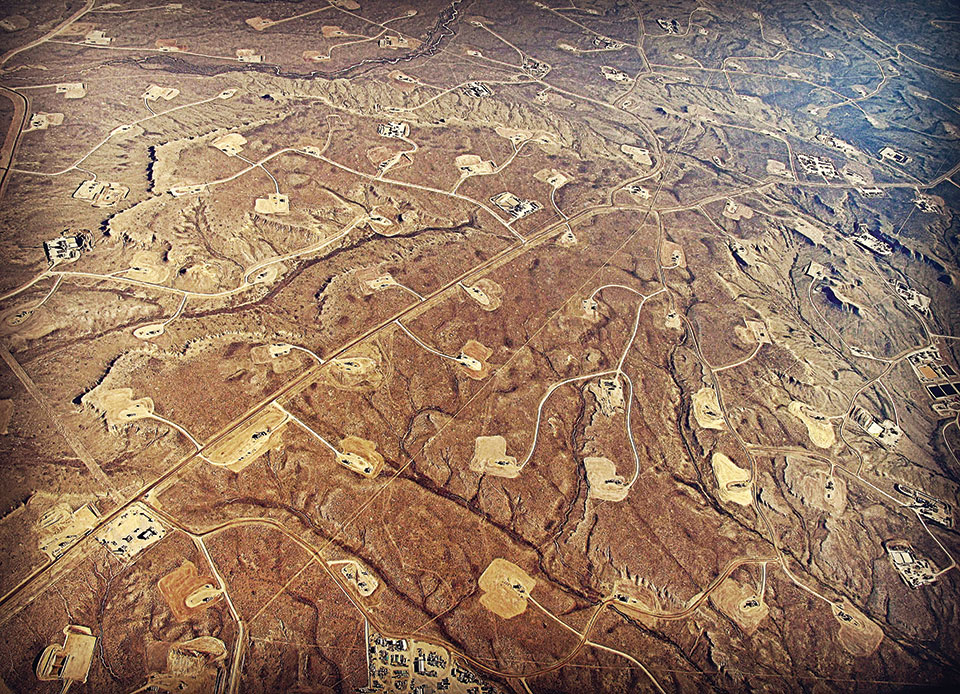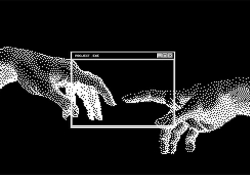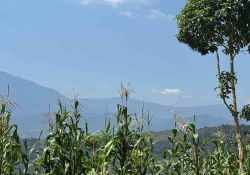Fracking Novels: Scrabble, Zombies, and the Problematized Real

The growth of hydraulic fracturing has inspired a subgenre of dystopian novels envisioning environmental destruction, governmental corruption, and more than one zombie apocalypse ending of the American Dream. Here, Susan Smith Nash, who is also a petroleum geologist, surveys how the unintended consequences of this controversial technology have driven the literary imagination of twenty-first-century novelists.
Hydraulic fracturing has been a disruptive technology in many ways. In brief, the sixty-year-old technique of pumping fluid and sand under pressure into an isolated productive oil or gas zone in a vertical zone was applied to three-mile-long horizontal wells in low-permeability shales. What was once a rather small-scale effort turned into a massive process, even acquiring a new name (“fracking” with a “k”). On one hand, fracking has allowed companies to tap into extremely “tight” reservoirs that could not be produced before. The large-scale operations often resulted in initial flows of thousands of barrels of oil and millions of cubic feet of gas a day, and the economic impact of the high-volume wells was dramatic. But on the other hand, as in all disruptive technologies, there are unintended consequences, and these are precisely what have inflamed the literary imagination and driven the urge to center narratives on hydraulic fracturing.
Though several novels each address a separate aspect of fracking, they share aspects in common: the destruction of the environment and the sub rosa machinations of large, powerful agents, usually corporate entities who colluded with corrupt and corruptible local and state governments and regulatory agencies. For example, James Browning’s The Fracking King (2014) takes place in northern Pennsylvania where the unlikely hero of the novel, Winston Crwth (rhymes with “truth”), enters a new boarding school where he is the reigning Scrabble champion. The novel, which incorporates many of the Scrabble games and looks like visual poetry, works on the margins of the knowable and the unknowable. While it never explicitly mentions Wittgenstein’s “the limits of my language mean the limits of my world,” other issues in the Tractatus Logico-Philosophicus (1921) bubble up from the subsurface like the chemicals used in hydraulically fracturing the Marcellus shale and which find their way into the groundwater and local rivers.
Browning’s hero, an awkward sophomore who finds himself in a place where methane seeps into wells and causes water flowing from faucets to burst into flame, pieces together the disparate facts and seemingly unrelated occurrences to bring together an interpretation that can be “read” like the words on a Scrabble board. And, like Crwth’s Scrabble games, the players have a chance to challenge whether or not the word (and thus any possible meanings) exists as a word. In the book, the most powerful word, “frack” or “fracking,” is a nonword, and yet it is the most powerful word of all.
What could be a rather typical novel about corporate secrets and the impact of collusionary activities between powerful out-of-town companies and corruptible officials becomes something else with Browning’s incorporation of Scrabble and the meditation on the power of language in deliberately controlling the real and the perceivable. Crwth’s father, a history professor at a boarding school, had his own encounter with how phenomena can suddenly either be unknowable or knowable when his field of study, “So Fo Po, or Soviet Foreign Policy,” is removed from the sphere of the real when “the Soviet Union suddenly [goes] belly up.” Scrabble provides the opportunity to experience the frisson of naming as a generative ontological process (as in William H. Gass’s On Being Blue: A Philosophical Inquiry [1975]) to generate being-ness, whether via categories or simply by triggering thoughts and associations. Or the process can be a nihilistic one, where words themselves no longer have meaning or are relegated to “nonword” status.
By expanding the limits of language, the limits of the world are broadened, and Crwth is able to expose not only the existence of pollution in areas that were carefully restricted from public access (such as in a polluted stretch of the river) but also the way that the state agency in charge of environmental protection had made sure that all the water quality tests resulted in a positive outcome by not including the most likely chemical pollutants on the “Test For” lists. Thus, the most toxic chemicals are not only not detected, in occupying that invisible realm, they exist within the realm of the unknown and the unknowable, simply because they have been removed from the lexicon.
In a pivotal Scrabble tournament, Crwth lures the pro-fracking Pennsylvania governor into forming the word “frack,” which he gleefully announces is not a word at all. She not only loses the game but also her attempt to keep the unknowable in that realm of nonbeing. “Fracking” is not a legal word in Scrabble, but of course, to the audience it is a word with all its attendant meanings. The dynamic between the knowable and the unknowable hinges on the existence of words and their legitimacy in the world. The agency of language in the phenomenal world is startling in The Fracking King, because it suggests that without the words, there is little that can be done to make intentional alterations in the world, irrespective of what might happen to the bodies of animals, human beings, plants, and the earth itself. It problematizes the real.
Blind Thrust (2015), by Samuel Marquis, tackles the issue of earthquakes triggered by the injection of millions of barrels of produced water (basically wastewater) into deep wells. Marquis, an environmental hydrogeologist, incorporates his technical knowledge of geomechanics into the narrative so that the reader understands how and why catastrophic earthquakes could be triggered. Marquis is not the first writer to be inspired by induced seismicity. Before Marquis, Jonathan Franzen wrote about toxic wastewater injection–triggering earthquakes in Strong Motion (1992).
Technology creates an opportunity to better understand the “truth” of the structure of the Front Range, the Rocky Mountains, and the complex interaction of stresses, strains, faults, and fractures—all of which are in no way static, hence the danger. While technology (combined with greed) is responsible for the problem of earthquakes, in the hands of Joseph Higheagle, the environmental geologist and protagonist, it’s also a lever of “truth” and invokes Heidegger’s “The Question Concerning Technology,” that technology is a process of revealing truth and knowledge about things that have been hidden in the past. Although the source of the wastewater was different, injected wastewater induced earthquakes in the past as well. From 1963 to 1967, a total of 1,300 earthquakes at the Rocky Mountain Arsenal near Denver were determined to have been generated by the disposal of more than 165 million gallons of toxic manufacturing byproduct wastewater. The oil company–hired hitman gloats about his high-tech sniper gear as he prepares to kill Higheagle and his son. His intent is to kill the first inhabitants. The company is likewise putting a hit on nature and then the environment.
The Fracking War (2014), by Michael J. Fitzgerald, takes on many of the real-life issues facing communities with new shale plays and their disruptive onslaught of hydraulically fractured horizontal wells. Written as a mosaic of newspaper articles in a newspaper in New York on the Pennsylvania border, The Fracking War introduces a way of reading that focuses itself on the act of looking for pathways into a truth that is assumed to be hidden and deliberately concealed. The newspaper reveals the oil company has used a legal loophole that protects trade secrets so they can get rid of hazardous wastes as they pump frack fluid into an injection well. I’m not sure the practice purported in the book is very practical or realistic—“Let’s mix this hazardous waste with frac fluid, slap a label on it, ‘frac fluid’ and we’re good!”—but nevertheless, the narrative shows how easily one moves from investigative journalism, which is courageous and revelatory, to the generation of conspiracy theories and disinformation.
As in the case of many of the narratives as they unfold in novels and in journalistic/social media discourse, The Fracking War addresses the disinformation of the interested parties (the beneficiaries of hydraulic fracturing and the oil). However, and rather ironically, journalism as “truth discourse” seems to have something of a blind spot to the fact that its own narrative careens toward conspiracy theory and imbues the violent (and sometimes murderous) with moral authority to achieve their goals by any means necessary. It’s interesting to see the narrative deconstruct itself—not along the lines of challenging hegemonic forces but by challenging the authority (and dominance) of the narrative (and its attendant way of reading) itself. It is fascinating to see at what point the investigative-journalism narrative crosses into the territory of conspiracy theories and at what point the reader anticipates that crossover and spontaneously weaves his or her own conspiracy theories ahead of its appearance in text.
The longed-for “truth” of causal relationships and unveiled conspiracies, which triggers a resurgence of a problematized “real,” is at the heart of other fracking novels. In Mark D. Campbell’s Fracked (2015), the first half of the book is an almost hyperreal description of day-to-day operations in drilling, completing, and stimulating (hydraulically fracturing) the Eagle Ford shale in south Texas. Fracked has the most accurate technical description of hydraulic fracturing. Ironically, it is also the most far-fetched, as its highly realistic first half quickly devolves into a full-on zombie apocalypse in the most desirable “liquids-rich” heart of the play.
The novel, which takes place in Tres Rios, a town halfway between San Antonio and Corpus Christi on I-37, features a battle against the leviathan, a multinational oil field services corporation, Triburton. The novel’s protagonist, John Oliver, is a rancher who now works with the hydraulic fracturing on the wells being drilled on the rancheswho comes to realize they’ve fracked into oil, gas, formation fluid, and an ancient virus that turns humans into legions of undead zombies. The author describes the behavior of the zombies with the same attention to detail as he gives the operations of hydraulic fracturing, which equates the fracking operations to zombies wantonly attacking anything that has a breath of life and then cheerfully munching their brains. The outbreak becomes so extreme that Triburton finds itself in a desperate war to exterminate the zombie menace, resulting in the nihilistic outcome, the total conflagration of the town of Tres Rios and its refinery. The company seems to have won the battle, but it fails to destroy all the barrels of oil that contain the “fracked” virus. It’s on a truck, it leaks, and turns a survivor into a zombie, who immediately slouches toward Houston.
Zombie apocalypse fracking novels suggest that zombies are the natural outgrowth of the American Dream. The fact that zombies tend to be comprised of the working-class or middle-class “everyman” suggests that they are victims of shadowy hegemonic government-enterprise juggernauts. However, the “everyman” zombies are not so much victims as mirrors of the corporate/corrupt government leaders who are zombies themselves, if not simply aliens from another planet (or dimension). The ecowarriors/activists manage to hang onto their humanity—not so much because they are impervious to the idea of infinite and immediate self-actualization (in a hyperdrive American Dream) but because they are the “true believers” (as in The Fracking Cult Murders).
England has been a flash point for protests against hydraulic fracturing of onshore gas and oil reservoirs, often associated with shale or coal-bed methane. Hydraulic fracturing is nothing new in Great Britain and has been used in the North Sea. There, production from oil reservoirs has resulted in subsidence and extraction-triggered earthquakes, particularly in the Ekofisk field near Norway. Such experiences, combined with influential antifracking movies such as Gasland (dir. Josh Fox, 2010) have provided impetus for environmental activists such as Frack Off: Extreme Energy Action Network, who have organized to block the mile-long laterals and multistage hydraulic fracturing. Not surprisingly, English authors have written fracking novels, which share certain attributes with American novels such as violent grassroots resistance and the emergence of zombies. Interestingly, there are also echoes of Victorian-era industrial novels (Benjamin Disraeli’s Sybil; or, The Two Nations, Charles Dickens’s Hard Times, and Elizabeth Gaskell’s North and South), with the pervasive gloom and stench of carbon-based energy (coal, oil, and natural gas) and the persistence of steam-powered devices. This is most apparent in Alan (Fred) Pipes’s The Fracking Cult Murders (2014) where the activists’ primitivism creates an earthiness that reinforces their essential humanity and contrasts them with the mechanical, heartless, and duplicitous politicians and technocrats.
Environmental activists must fight zombies as well as industrialists in English author Ian D. Moore’s Salby Damned (2014), which takes place in Yorkshire, England. As in the case of The Fracking Cult Murders, the fracking takes place in locations impacted by the nineteenth-century Industrial Revolution. Here, in Yorkshire, England, fracking operations open up reservoirs that contain a deadly zombie-producing virus. The virus-unleashing accident happens when someone decides to use mining-type blasting to speed up drilling. That was a bad idea, not only because of the zombie fluids but also because, technically, blasting does not make sense. One would geosteer around the formation in order to stay in the zone. If the zone is discontinuous, it means there is no more zone, so why keep drilling? Granted, zombies are not a hallmark of realist fiction, but in fracking novels, suspension of disbelief relies on precise, up-to-date technical details. But Moore is in good company. Trying a highly dangerous and inadvisable technique to solve a problem on the cheap is often the precipitating action in an end-of-the-world sci-fi novel. As such, it follows the tradition of English science-fiction authors with an apocalyptic bent such as H. G. Wells, Jules Verne, and J. G. Ballard. And, on another level, the absurdity of some of the decisions mirrors the behavior of the zombies—irrational and focused on one thing, and one thing only—to ravish and devour everything that sports eatable flesh and a heartbeat.
There is a powerful social commentary in a zombie apocalypse; namely, that everyone becomes a zombie in an unregulated capitalist-consumer culture. To maintain your humanity means you have to live in a tree or underground. Your daily living choices are limited. You can be an activist binding up your wounds with scavenged medical supplies or a recluse in a pilly sweater who nostalgically tends the artifacts of culture, idly leafing through a description of life after the plague in Boccaccio’s Decameron.
•
Literary and artistic responses to the massive multistage hydraulic fracturing operations reflect the public’s deep unease about the intersections of industrialization and natural resources and the unintended consequences of technology. In addition, some aspects of the novels offer a critique of a consumer culture that sacrifices everything for appetite. The message is embodied in the behavior of zombies, who both represent the victims of fracking and the process itself. In a time of rapid change, part of the technological advances (and their consequences) involve the unknowable, and the fracking novels explore narrative constructions of reality, where meaning is problematized when we realize that the most powerful phenomena are things we do not even have a name for, or a being-ness that is in flux and inadequately represented by language. In such cases, the process of trying to discover meaning can devolve all too easily into conspiracy theory or a spy novel. A prevailing characteristic of fracking novels is a good-versus-evil struggle and the pursuit of a persistent “truth” in the face of a world where both truth and untruth are shown to be manipulative constructs.
University of Oklahoma
Hydraulic fracturing, commonly referred to as “fracking,” is a complex process. When first developed in the 1940s, it was performed on vertical wells on the zone of interest, usually no more than twenty feet thick. Now, with horizontal drilling, the fracked zone can be as long as thirty thousand feet in lateral extent, and there can be fifty or sixty “stages” requiring a fleet of tank trucks with water, chemicals, and proppant (sand or coated grains).
The danger of environmental contamination generally occurs in problems with the surface casing; in spills during the cleanup in preparation for the activity, where chemicals are pumped down the hole in order to dissolve carbonates and “clean up” the formation; in storing and transporting chemicals, water, and proppant slurry; in the hydraulic fracturing process itself; in the production of the oil, gas, and formation fluids; and in the disposal of produced water, which can represent up to 97 percent of the fluids flowing from the well thanks to the fact that the oil and gas production itself often declines within months to a fraction of its initial volume.
This water is piped or trucked to a disposal well where the produced water (wastewater) is injected into a deep well that happens to have a receptive formation (usually limestone) that seems to drink up all the fluid you care to pump into it. Significantly, one well can produce as many as five thousand barrels (twenty thousand gallons) of fluid per day. So the volumes being removed from one formation and then pumped into another (at another depth—usually a mile deeper) can be truly staggering. The injection of water into formations such as the Arbuckle Lime has been blamed for earthquakes (referred to as induced seismicity) in Ohio, Texas, Arkansas, Oklahoma, and Kansas, just to name a few. – Susan Smith Nash













